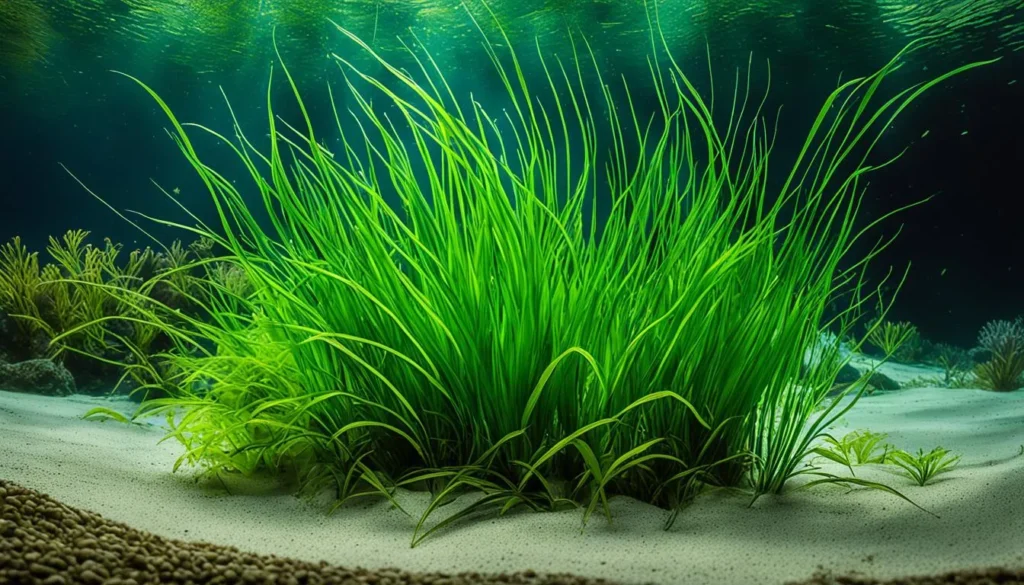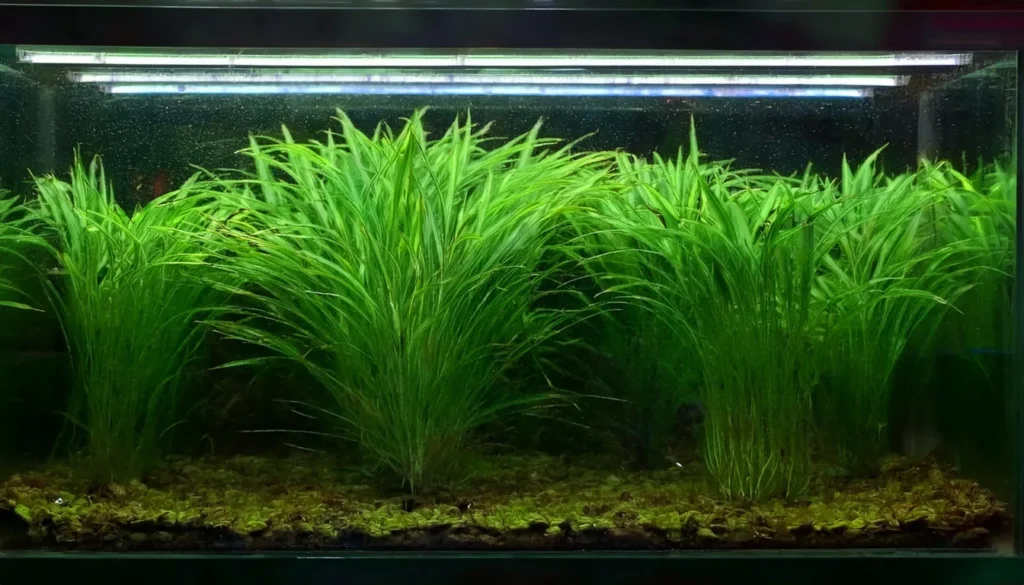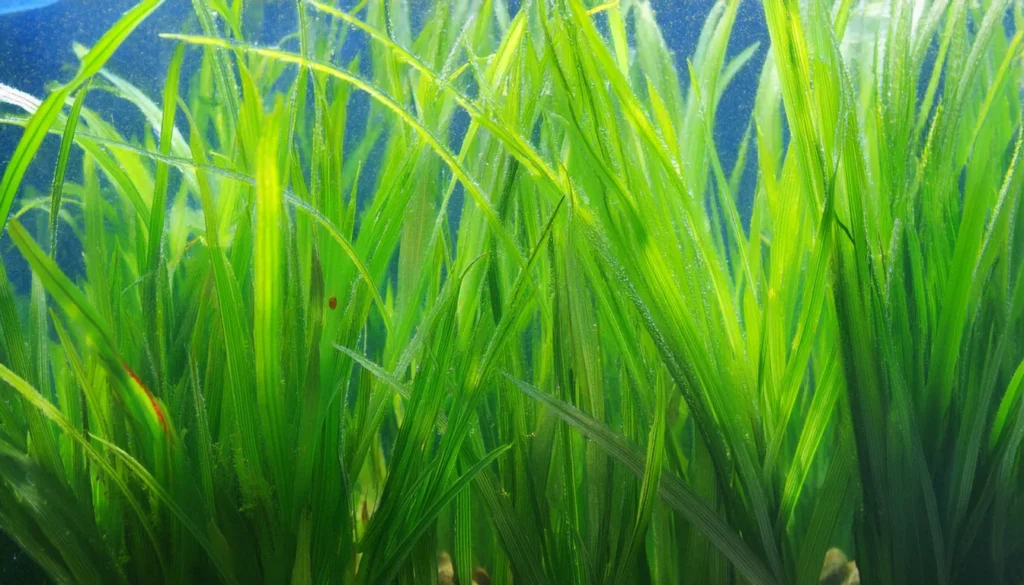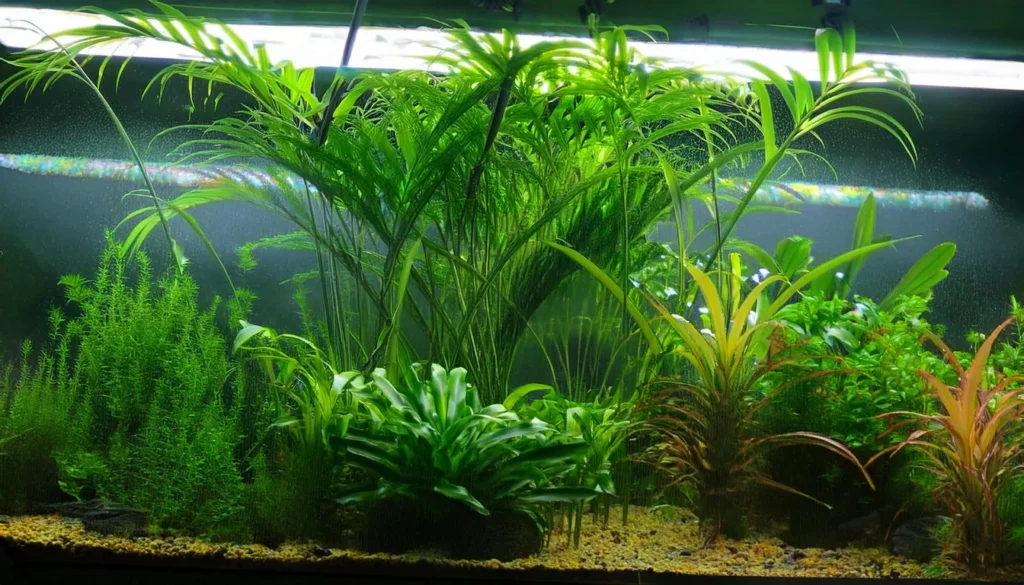Welcome to our comprehensive guide on the ecology of Jungle Vallisneria, a fascinating aquatic plant that plays a vital role in supporting and sustaining aquatic life.
In this article, we will explore the ecological significance of Jungle Vallisneria, its adaptations for aquatic life, and its role as a natural water purifier in aquatic ecosystems.
We will also delve into its interspecies relationships, propagation strategies, and the challenges it faces in today’s changing world.
Join us as we uncover the wonders of Jungle Vallisneria and its crucial place in the intricate web of life beneath the water’s surface.

Key Takeaway
- Jungle Vallisneria is a keystone species that is crucial in aquatic ecosystems.
- Its unique adaptations, such as root structures and leaf morphology, allow it to thrive in underwater environments.
- Jungle Vallisneria promotes biodiversity by providing food and habitat for aquatic fauna. It acts as a natural water purifier by absorbing excess nutrients and preventing eutrophication.
- Interspecies relationships with fish, insects, and microorganisms further contribute to the overall biodiversity of aquatic ecosystems.
Quick Stats
| Attribute | Details |
| Family Name | Hydrocharitaceae |
| Origin | North America |
| Height | 50-150 cm (20-59 inches), can reach the surface in taller tanks |
| pH Range | 6.5 – 8.5 |
| CO2 Requirement | Low |
| Growth Rate | Fast |
| Care Level | Easy |
| Color Form | Bright Green |
| Water Conditions | 18-30°C (64-86°F), adaptable to a wide range of hardness |
| Max Size | Leaves can grow over 1 meter long in ideal conditions |
| Lighting | Moderate |
| Supplements | Benefits from root tabs; liquid CO2 and fertilizers can enhance growth but not essential |
| Placement | Background |
| Propagation | By runners |
What Is Jungle Vallisneria?
Jungle Vallisneria, also known as Vallisneria americana, is a species of aquatic plants that plays a critical role in the biodiversity of aquatic environments.
Commonly found in freshwater habitats such as rivers, lakes, and ponds, jungle vallisneria is known for its unique adaptations that allow it to thrive in these watery ecosystems.
Natural Habitat And Origin
Jungle Vallisneria, scientifically known as Vallisneria americana, is native to North and Central America, as well as the Caribbean.
It is found in various freshwater habitats, including rivers, streams, lakes, ponds, and marshes.
In its natural habitat, Jungle Vallisneria typically grows in shallow waters with sandy or muddy substrates and plenty of sunlight.
This aquatic plant species is well-adapted to both stagnant and flowing water conditions, making it a versatile inhabitant of diverse aquatic ecosystems.

Physical Characteristics
- Jungle Vallisneria (Vallisneria americana) is characterized by its long, ribbon-like leaves that can reach lengths of up to several feet (1 to 2 meters) under optimal conditions. The leaves are typically narrow and strap-like, with a rounded or slightly pointed tip.
- They arise from a central rhizome and are arranged in a rosette pattern. The plant’s roots anchor it firmly into the substrate, while its leaves extend upward toward the water’s surface to access light for photosynthesis.
- Jungle Vallisneria may also produce slender, branching flower spikes that emerge above the water’s surface and bear small, inconspicuous flowers. Overall, its graceful foliage and robust growth make it a popular choice for aquariums and ponds alike.
Lighting Requirements
- Moderate to High Lighting: Jungle Vallisneria typically thrives in moderate to high lighting conditions.
- Essential for Photosynthesis: Adequate light is essential for photosynthesis, the process by which plants convert light energy into chemical energy.
- Supports Healthy Growth: Providing moderate to high-intensity lighting ensures that Jungle Vallisneria receives sufficient light to support healthy photosynthesis and robust growth.
- Avoid Excessive Lighting: While Jungle Vallisneria requires sufficient light, it’s essential to avoid excessive lighting, which can lead to algae overgrowth or stress the plant.
- Customization: Adjustable aquarium lighting fixtures allow for customization to meet the specific lighting needs of Jungle Vallisneria and other aquatic plants in the aquarium.
- Consider Depth: Consider the depth of the aquarium and the light penetration required to reach plants situated at different levels within the tank.
- Monitoring and Adjustment: Regularly monitor and adjust the lighting duration and intensity based on the plant’s response and the overall ecosystem of the aquarium.

Temperature Parameters
- Temperature Range: Ideally, maintain water temperatures between 22°C to 28°C (72°F to 82°F) for Jungle Vallisneria.
- Tropical Environment: Jungle Vallisneria is accustomed to tropical environments, so it thrives in warmer water temperatures.
- Stable Temperature: It’s crucial to maintain a stable temperature within the recommended range to prevent stress and promote healthy growth.
- Aquarium Heater: Use an aquarium heater to regulate water temperature and prevent fluctuations, especially in colder climates or during seasonal changes.
- Avoid Extreme Temperatures: Avoid exposing Jungle Vallisneria to extreme temperatures outside of its preferred range, as it may lead to slowed growth, wilting, or even plant damage.
Optimal Water Condition
- pH Level: Maintain a slightly acidic to neutral pH level between 6.5 and 7.5. This range is suitable for most aquatic plants, including Jungle Vallisneria.
- Water Hardness: Jungle Vallisneria can tolerate a wide range of water hardness levels, but it typically thrives in moderately hard to hard water. Aim for a general hardness (GH) of 4 to 15 dGH.
- Temperature: Keep the water temperature within the range of 22°C to 28°C (72°F to 82°F). This range mimics the tropical environments where Jungle Vallisneria naturally grows.
- Ammonia and Nitrite Levels: Ensure that ammonia and nitrite levels remain at zero. These compounds are toxic to fish and plants, including Jungle Vallisneria.
- Nitrate Levels: Keep nitrate levels low, ideally below 20 ppm. While Jungle Vallisneria can absorb nitrates as nutrients, excessively high levels can lead to algae growth and stress the plant.
- Carbon Dioxide (CO2): Jungle Vallisneria can benefit from supplemental CO2, especially in densely planted tanks or those with high lighting. However, it can also thrive in tanks without additional CO2 supplementation.
Substrate Requirement
- Fine Substrate: Jungle Vallisneria prefers a substrate with a fine texture, such as sand or fine gravel. This type of substrate allows the plant’s roots to anchor securely while allowing for easy penetration and growth.
- Nutrient-Rich Substrate: While Jungle Vallisneria can obtain nutrients from the water column, providing a nutrient-rich substrate can promote healthier and more vigorous growth. Consider using specialized aquatic plant substrates or adding root tabs to enrich the substrate with essential nutrients.
- Depth: The substrate depth should be sufficient to allow the plant’s roots to establish and spread comfortably. A depth of at least 2 to 3 inches (5 to 7.5 cm) is recommended to provide adequate anchorage and stability for Jungle Vallisneria.
- Stability: Ensure that the substrate is stable and does not shift or compact easily. Jungle Vallisneria roots deeply into the substrate, so stability is crucial to prevent uprooting and damage to the plant.

Placement Option In The Tank
- Background Planting: This plant is often used as a background plant due to its tall and graceful foliage. Planting it along the back or sides of the aquarium creates a lush green backdrop that adds depth and dimension to the tank.
- Midground Planting: While this plant is typically considered a background plant, shorter varieties can be used effectively in the midground. Placing them slightly closer to the front of the tank can help fill in empty spaces and provide a transition between foreground and background plants.
- Island Planting: Create islands or clusters of Jungle Vallisneria within the aquarium to add focal points and visual interest. Planting them in groups of varying heights can create a naturalistic look and mimic the plant’s growth pattern in the wild.
- Borders and Pathways: Use Jungle Vallisneria to define borders or pathways within the aquarium. Planting them along the edges of rocks or driftwood formations can help soften hard lines and create a more natural transition between hardscape elements and plants.
Recommended Tank Size
- Small to Medium Tanks: For smaller tanks, such as nano or desktop aquariums, Jungle Vallisneria can still be a suitable option, especially if you select shorter varieties like Vallisneria nana. A tank size of 10 gallons (38 liters) or larger is recommended to provide adequate space for planting and growth.
- Medium to Large Tanks: In medium to large tanks, this plant can be used effectively as a background plant to create a lush green backdrop. Tanks ranging from 20 gallons (75 liters) to over 100 gallons (380 liters) are suitable for accommodating taller varieties of Jungle Vallisneria, allowing them to reach their full height potential.
- Consider Planting Density: When determining the appropriate tank size for Jungle Vallisneria, consider the planting density and the number of plants you intend to use. Leave enough space between plants to prevent overcrowding and allow for proper growth and development.
- Aquascape Design: The tank size should also complement your overall aquascape design and provide enough space for other aquatic plants, hardscape elements, and aquatic inhabitants.

Suitable Tank Mates
- Community Fish: Peaceful community fish species such as tetras, rasboras, danios, gouramis, and livebearers can make excellent tank mates for Jungle Vallisneria. Avoid aggressive or nippy species that may damage the plant’s delicate foliage.
- Bottom Dwellers: Bottom-dwelling fish like corydoras catfish, loaches, and small plecos can complement Jungle Vallisneria by foraging around the substrate and adding activity to the lower levels of the tank.
- Shrimp and Snails: Dwarf shrimp species such as cherry shrimp and amano shrimp, as well as small freshwater snails like nerite snails and mystery snails, can help clean algae and detritus from the aquarium while coexisting peacefully with Jungle Vallisneria.
- Small to Medium-Sized Cichlids: Some small to medium-sized cichlid species, such as dwarf cichlids (e.g., German blue ram, Apistogramma species), can be compatible with Jungle Vallisneria in a well-planned community tank. However, it’s essential to research the specific temperament and compatibility of each cichlid species before adding them to the aquarium.
RELATED: A Splash Of Color With Alternanthera Variegatus For Your Aquatic Garden
Nutritional Requirements
- Macronutrients: This plant requires macronutrients such as nitrogen (N), phosphorus (P), and potassium (K) for healthy growth. These nutrients can be supplemented through fish waste, decaying organic matter, and regular water changes. Additionally, aquarium fertilizers containing macronutrients can help maintain optimal nutrient levels in the water column.
- Micronutrients: In addition to macronutrients, Jungle Vallisneria also requires micronutrients like iron (Fe), manganese (Mn), and zinc (Zn) for proper growth and development. These micronutrients are essential for various biochemical processes, including chlorophyll synthesis and enzyme activation. Aquarium fertilizers formulated with micronutrients can help ensure that Jungle Vallisneria receives all the essential trace elements it needs.
- Carbon Dioxide (CO2): Although it can utilize carbon dioxide (CO2) from the water column, supplementing CO2 can enhance its growth rate and overall health, especially in tanks with high lighting and densely planted setups. CO2 injection systems or liquid carbon supplements can help provide additional carbon for optimal photosynthesis.

Jungle Vallisneria Cultivation Tips
- Selecting Healthy Specimens: Start with healthy Jungle Vallisneria specimens free from signs of damage, decay, or pests. Look for plants with bright green foliage and strong root systems.
- Substrate Preparation: Prepare a suitable substrate for Jungle Vallisneria, such as fine sand or gravel. Ensure that the substrate is nutrient-rich and provides adequate anchorage for the plant’s roots.
- Planting Depth: Plant Jungle Vallisneria in the substrate at a depth of 2 to 3 inches (5 to 7.5 cm). Ensure that the crown (where the leaves emerge from the roots) is above the substrate to prevent rotting.
- Spacing: Space Jungle Vallisneria plants apart to allow room for growth and prevent overcrowding. Aim for a spacing of several inches between each plant to promote optimal development.
- Lighting: Provide moderate to high-intensity lighting for Jungle Vallisneria to support photosynthesis and healthy growth. Ensure consistent lighting duration and intensity to prevent fluctuations and promote robust foliage development.
- Water Parameters: Maintain stable water parameters within the recommended range for Jungle Vallisneria, including temperature, pH, and hardness. Regular water testing and adjustments are essential to ensure optimal conditions for plant growth.
Plant Propagation Tips
- Runners: Jungle Vallisneria propagates primarily through runners, which are horizontal stems that extend from the main plant. These runners produce new plantlets, known as daughter plants, along their length.
- Encourage Runner Growth: Provide optimal growing conditions, including sufficient light, nutrients, and water parameters, to encourage Jungle Vallisneria to produce runners. Healthy and well-established plants are more likely to produce runners.
- Separating Daughter Plants: Once the daughter plants on the runners develop their own roots and shoots, they can be separated from the parent plant. Carefully cut the runner between the parent plant and the daughter plant using sharp scissors or a clean knife.
- Planting Daughter Plants: Plant the separated daughter plants in the substrate at the desired location in the aquarium. Ensure that the crown (where the leaves emerge from the roots) is above the substrate, and the roots are buried in the substrate.
- Provide Adequate Space: Space the daughter plants apart to allow room for growth and prevent overcrowding. This ensures that each plant receives sufficient light and nutrients for optimal development.
Benefits Of Planting Jungle Vallisneria
- This plant is a keystone species in aquatic ecosystems due to its significant contribution to biodiversity. These plants create a complex and highly productive habitat that supports a diverse range of organisms.
- The dense vegetation of this plant beds provides shelter, food, and breeding grounds for various aquatic fauna such as fish, invertebrates, and amphibians. The spatial complexity of this plant also helps prevent predation and serves as a refuge for vulnerable species.
- Jungle vallisneria also plays a crucial role in nutrient cycling and ecological balance. The plants absorb excess nutrients, such as nitrogen and phosphorus, from the water column, thereby reducing the likelihood of eutrophication and maintaining the overall health of the aquatic ecosystem.

Conclusion
Throughout this article, we have explored the fascinating ecology of this plant and its crucial role in aquatic ecosystems.
As a keystone species, this plant supports a wide range of aquatic life, contributing to our water systems’ overall biodiversity and health.
Another noteworthy aspect of this plant is its ability to promote water purification.
Absorbing excess nutrients from the water column, such as nitrogen and phosphorus, helps prevent eutrophication and maintain balanced aquatic ecosystems.
This natural water purifier plays a vital role in preserving the quality of our water resources.
Moreover, this plant exhibits remarkable adaptability to its aquatic environment.
Its unique adaptations, from root structures to leaf morphology, enable it to thrive in diverse aquatic habitats.
These adaptions, coupled with ecosystem interactions, such as providing shelter and food sources for various aquatic species, contribute significantly to aquatic ecosystems’ overall health and stability.
Furthermore, the potential of this plant in phytoremediation efforts must be considered.
This plant can absorb and detoxify contaminants, including heavy metals and organic pollutants, from contaminated water bodies.
By harnessing this natural ability, we can explore new avenues for environmental restoration and remediation.
Frequently Asked Questions
What Are Some Interspecies Relationships Involving Jungle Vallisneria?
This plant forms various interspecies relationships within aquatic ecosystems.
It provides shelter and food sources for fish, insects, and microorganisms.
Some fish species, such as certain cichlids and turtles, use this plant as a spawning site or refuge.
In return, these organisms contribute to pollinating and dispersing seeds.
How Does Jungle Vallisneria Reproduce?
This plant reproduces through both natural and human-assisted methods.
It produces flowers with male and female parts, allowing for pollination and seed production.
Additionally, the plant can reproduce vegetatively by producing new shoots or plantlets. Humans can aid in propagating this plant through cultivation and transplantation efforts.
How Do I Set Up A Planted Tank With Jungle Vallisneria?
To set up a planted tank with this plant, you must provide the right conditions for growth.
This includes providing adequate lighting, maintaining stable water temperature, and ensuring appropriate water parameters.
A nutrient-rich substrate and regular fertilization are also important for the optimal growth of jungle vallisneria. Long-term care involves trimming, removing dead leaves, and monitoring water quality.
What Are The Challenges Facing Jungle Vallisneria?
This plant faces challenges such as pollution and climate change.
Nutrient pollution, chemical contaminants, and sedimentation can negatively impact the health and survival of this plant.
Climate change can lead to rising temperatures, changing precipitation patterns, and altered water flow, affecting the growth and distribution of aquatic plant species, including this plant.
Can Jungle Vallisneria Be Used In Phytoremediation?
Yes, this plant can be used in phytoremediation efforts.
This plant has the ability to absorb and detoxify contaminants, such as heavy metals and organic pollutants, from contaminated water bodies.
Its efficient nutrient uptake mechanisms and robust growth make it a promising candidate for water purification and environmental remediation projects.
- Unveiling The Wonders Of Riccia Fluitans In Aquascapes - August 7, 2024
- Vallisneria Gigantea Var. Guide To Care And Cultivation At Home - July 31, 2024
- Vesicularia Dubyana Care & Growth Guide Tips For Beginner Gardeners - July 30, 2024
